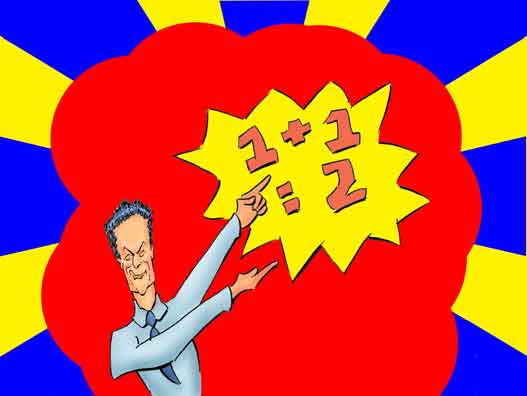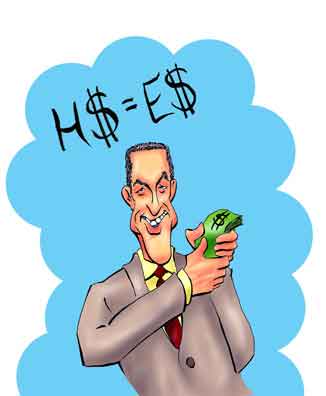Richard Feynman

Richard Feynman
The Great Communicator
(Click on image to zoom in and out.)
Richard Feynman is most famous as the author of The Feynman Lectures which are an introduction to physics. This led to Richard's name being appropriated to describe various teaching and learning phenomenon.
What is less known is that Richard (or Dick as he was known to his friends) also developed a new approach to quantum mechanics using what are called path integrals - a mathematical trick for looking at all possibilities of going from one place to another. A path integral is something that like multidimensional integarals:
∫f(x1, x2, x3, ..., xn)dx1dx2dx3...dxn
... but you have an infinite number of dimensions.
Let it be said that path integrals are a difficult topic. Even a mathematician once lamented he had trouble understanding them. The definitive book, Quantum Mechanics and Path Integrals, written by Richard and his student and colleague, Albert Hibbs, is still the basic introduction to the topic.

Albert Hibbs
Richard's "Student"
In any case Richard's approach was unique enough that 1) it resulted in a specific name for the integrals as (what else?) Feynman Path Integrals and 2) made Richard a leader in the further development of quantum mechanics, specifically in quantum electrodynamics. In 1965 these achievements landed Dick and two of his colleagues, Sin-Itiro Tomonaga and Julian Schwinger, the Nobel Prize for Physics.
But to the general public, Dick remains best known as a lecturer and educator. But he was also a life-long learner himself, advocating the Feynman Method (not necessarily named by Dick) of self-instruction. That is to learn something try to imagine you're going to explain it to someone else. The crux is if you can explain it simply, you understand it. If you can't explain it simply, you don't understand it. Dick's method is particularly suited to today's technology where you can post explanations on websites in an effort to eradicate ignorance and superstition.
There's a corollary to the Feynman Method. If no one can explain a matter simply, then no one really understands it. Dick realized this was true for quantum mechanics. Although anyone who is informed and intelligent can't doubt it's true, no one, regardless of how well informed or intelligent they are, really understands it.
There is a big difference in calculating something and explaining it. Much of - quote - "explaining theories" - unquote - is just stating the math. For instance, to explain what an electric field is, someone will say it's the force that is experienced by a charged "test" particle at a point in space when another charged particle is placed near it divided by the charge of the test particle. So you write the equation:
E = F/q
where E is the electric field strength, F and q are respectively is the force and charge of the test particle which "feels" the force.
This, though, explains how to recognize an electric field, what it does, and how to calculate the magnitude. It does not explain exactly what it is.
The problem, then, is that most people consider an explanation of a theory is one that gives us a physical interpretation by using some everyday analogy. But at the subatomic level, there are just not any everyday analogies.
Richard knew this. When explaining the wave-particle duality of subatomic particles, he would point out that an electron is not a particle or a wave, but is something unique. It's behavior can be calculated with the mathematical approximations of a particle or a wave, yes, but it is not either one.
Sometimes, though, an everyday analogy helps to explain why you can't explain it. Isaac Asimov pointed out that asking if an electron is a particle or wave is like asking if a cone is a circle or a triangle. It is neither. But you can do "experiments" - turn it one way or another - that make it look like one or the other or a little of each.
Richard spoke in a rapid-fire machine gun style which was nevertheless very easy to understand and follow. He never lost his New York accent and some have remarked when you heard him talk, you always looked around for the cab.
During his lectures Richard was always careful to point out that you didn't actually need to invent a new or radical theory like quantum mechanics or relativity to explain the world. But if you tried to stick with your old theories and tweak them to cover new facts, then your theory ended up being either too complex or too ridiculous. And if you designed experiments to show quantum mechanics or relativity was wrong, the experiments always fail. At least they have so far.
Ironically, with his ability as a scientist, speaker, and teacher, Richard was also responsible for what educators call the Feynman Effect. The Feynman Effect is used to describe related, although not identical, pedagogical phenomena.
One Feynman Effect is what happens if a speaker actually attracts an audience for which the lectures are not intended. This effect has been cited when talking about the famous Feynman Lectures. Intended as an introduction to physics for beginning students, the talks are much more enjoyed by people who already understand the basics. The usual story is that when the lectures were first presented, there was a majority of undergraduates present. But as the lectures proceeded, the undergraduates began to fade away to be replaced by advanced students and even professional scientists. The lectures are well-presented, thorough, and entertaining, but not necessarily in the manner originally intended.
The other Feynman Effect is when a teacher is such a good and entertaining speaker, the students walk away thinking they have gained a true understanding of the subject. But when they attempt to apply their knowledge to solve problems, they find themselves at a loss. The moral is that the boring, dull teacher you had for Physics 101 might not be that bad after all.
Richard himself was surprisingly modest, even when talking about his successes. He readily admitted he was sometimes seen as a genius when actually he was lucky. While working as a group leader on the Manhattan Project he was sent to Oak Ridge, Tennessee to review safety procedures of the plant. Some engineers showed him blue prints of the plant, saying that there were safety valves to prevent accidents. Richard had no idea what the symbols meant. At random, he pointed to one point - he wasn't sure if it was a valve or a window - and asked "What happens if this valve gets stuck?" The engineers immediately realized that there would be a catastrophic accident and immediately put in a new safety devices. They all said how Richard was a genius.
Richard also was modest about his actually inherent ability, pointing out he had an IQ of "only" 127. But at least, he said, that was 10 points higher than John F. Kennedy who became President. On the other hand, it's likely Richard's real IQ was much higher than the test score which simply reflected that - when you get down to it - IQ's are really nothing more than what you score on an IQ test invented by educators and psychologists in Western culture.
References
Surely You're Joking, Mr. Feynman: Adventures of a Curious Character, Richard Feynman, Norton, 1984. Richard's autobiography.
Tuva or Bust: Richard Feynman's Last Journey, Ralph Leighton, 1991.
Quantum Mechanics and Path Integrals, Richard Feynman and Albert Hibbs, McGraw-Hill, 1963, (Dover Reprint, 2010). An interesting aside is that Albert was once a contestant on You Bet Your Life hosted by Groucho Marx during the time that he and Richard were writing the book. On the show Albert asked if Grouch would like a copy.
Albert also said he had developed a method for winning at the casinos by identifying biased roulette wheels. As reported in Life Magazine (December 8, 1947), Al and his friend, Roy Wolford, turned $100 to $14,000. But at another casino the system didn't seem to work. When their winnings whittled down to 6,500, they left.
Today Albert's claim that he beat the wheel is widely accepted. However at the time hard-nosed gamblers said Albert and Roy just got lucky.
Quantum Mechanics with Applications, David Beard and George Bead Allyn and Bacon, 1970 (First Edition, 1963; Dover Reprint, 2014). This book also includes Richard's development of quantum mechanics using path integrals. But as the blurb says, a "solid foundation in quantum mechanics and atomic physics is assumed." So to understand this book about quantum mechanics and atomic physics, you need to understand quantum mechanics and atomic physics.
"Learn Anything In Four Steps With The Feynman Technique", Curiosity (Makes Your Smarter)
Understanding Physics, Volume 2: Light, Magnetism, and Electricity, Isaac Asimov, Walker and Company, 1966.